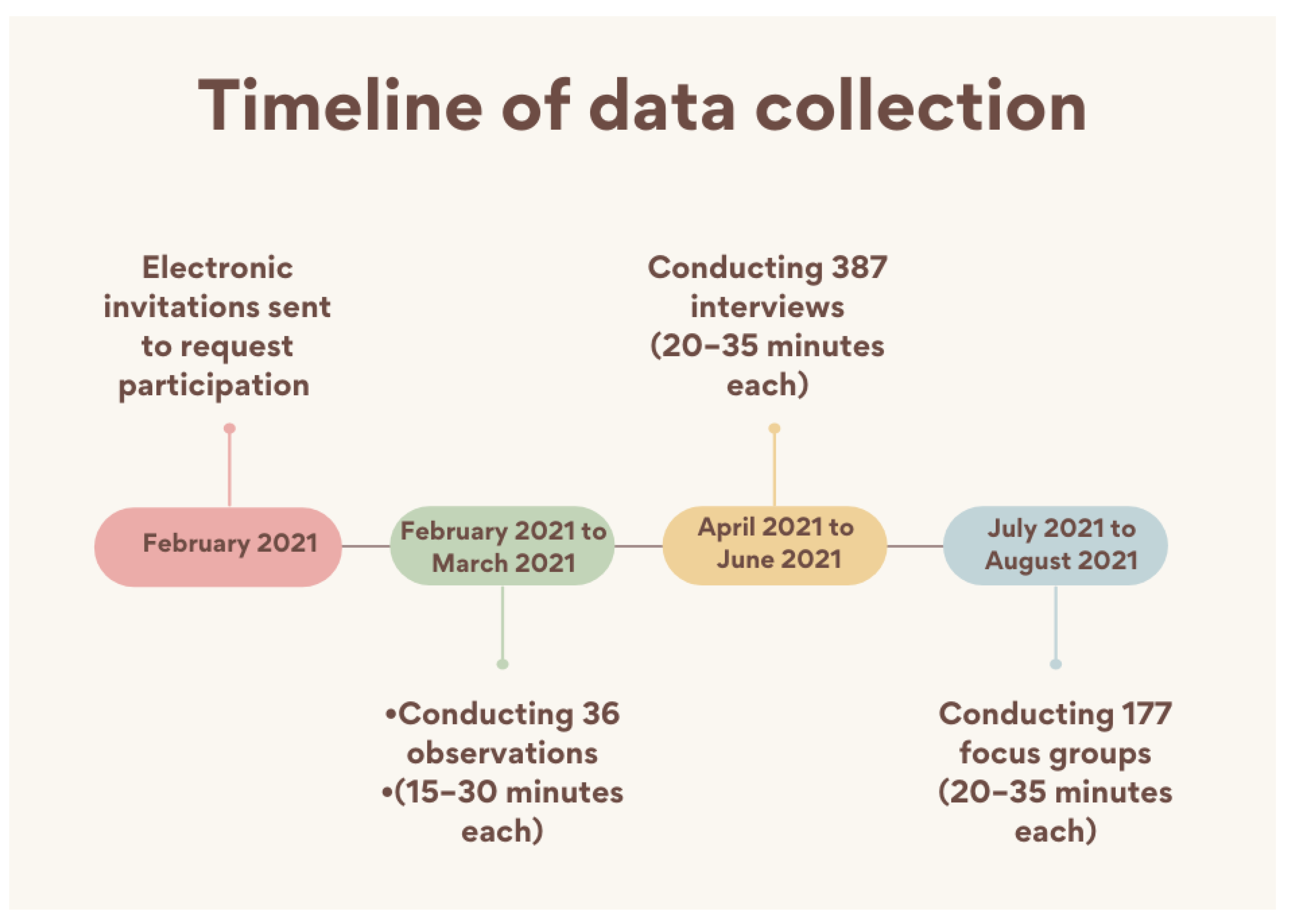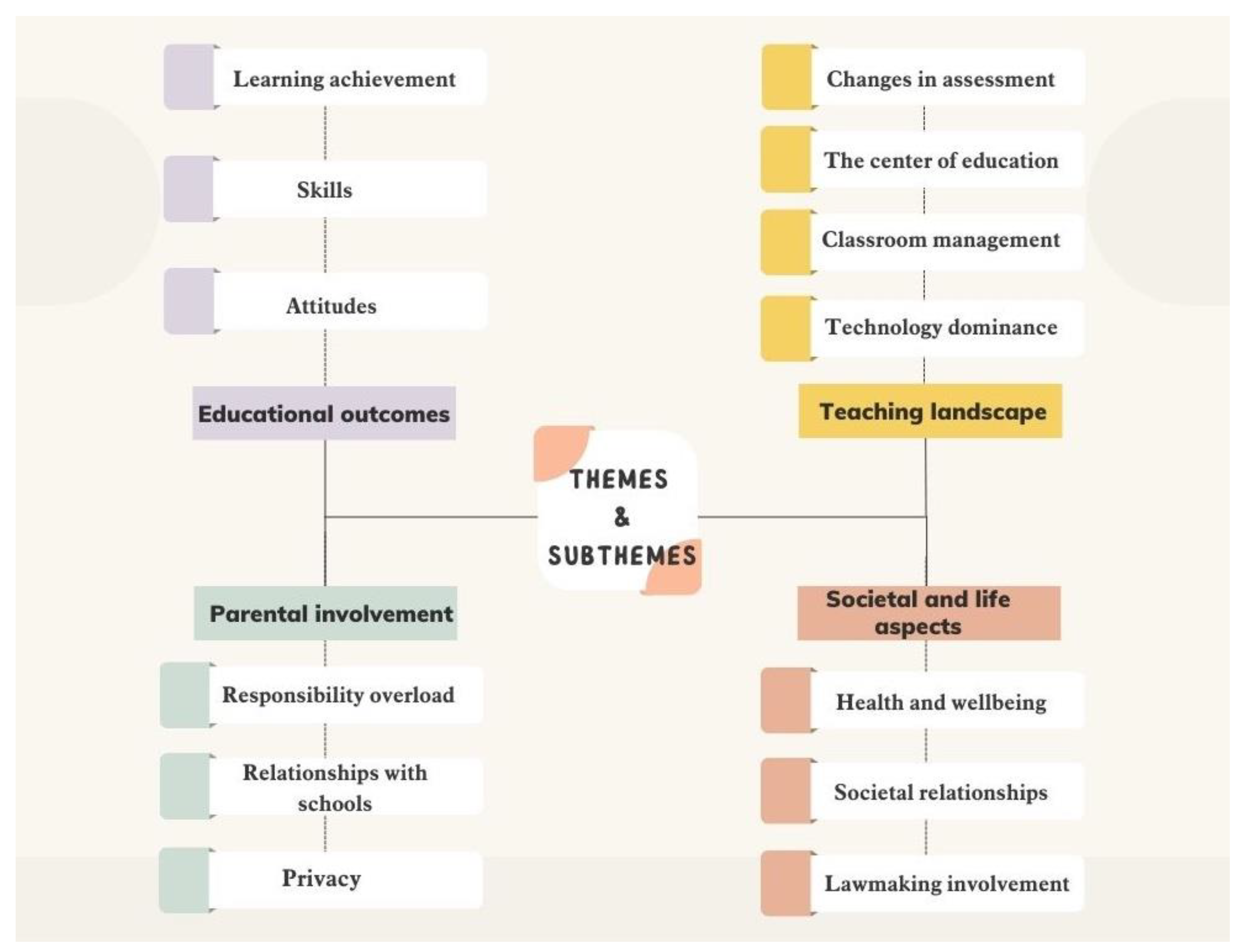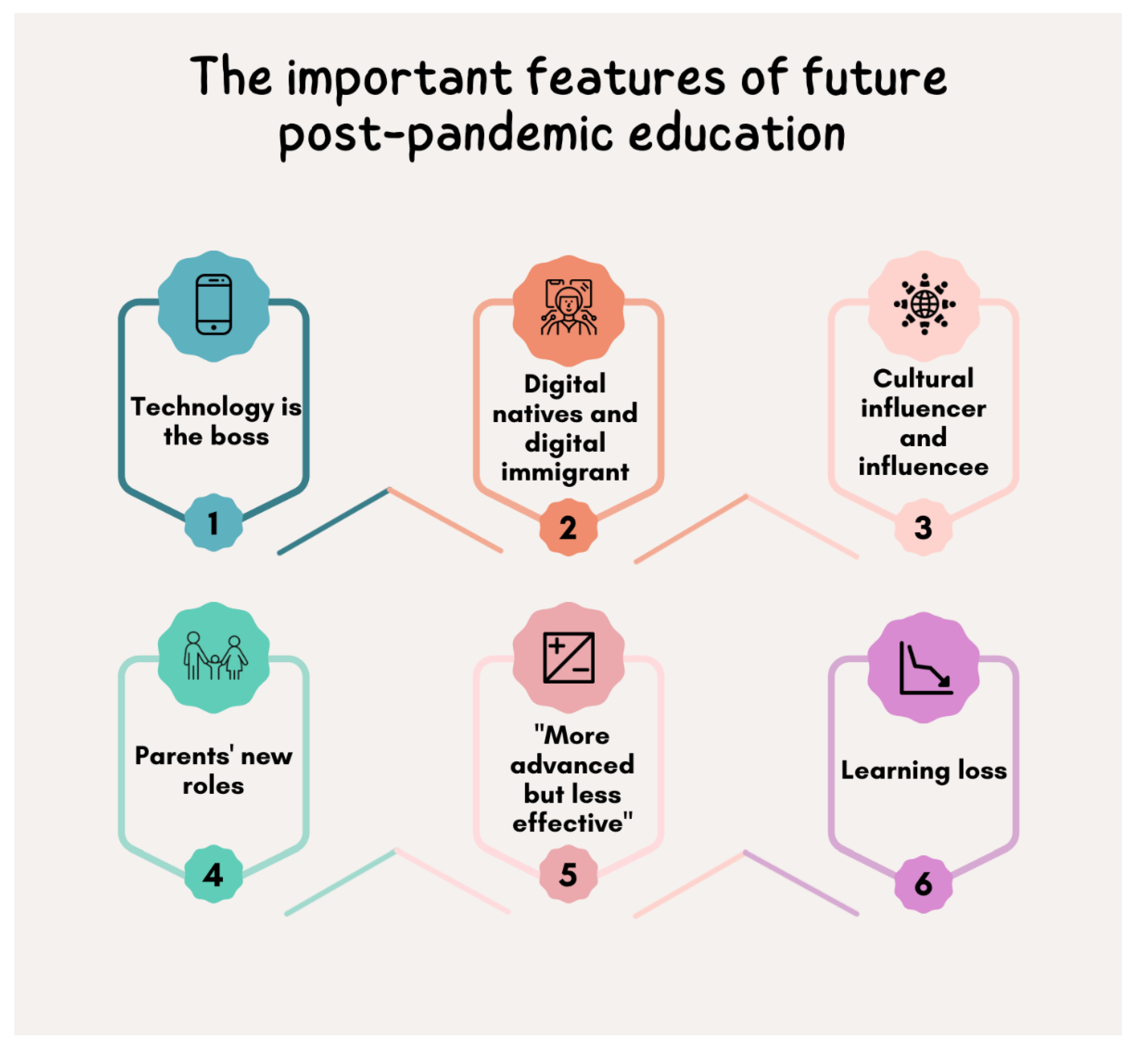Ethnographic Reflections of K–12 Distance Education in Saudi Arabia: Shaping the Future of Post-Pandemic Digital Education
Abstract
:1. Introduction
2. Literature Review
Distance Education during COVID-19
3. Methodology
3.1. Research Design
3.2. Participants
3.3. Data Collection Methods
3.4. Data Collection Procedure
3.5. Data Analysis
3.6. Trustworthiness
4. Findings
4.1. Educational Outcomes
4.1.1. Attitudes
4.1.2. Skills
4.1.3. Learning Achievement
4.2. Teaching Landscape
4.2.1. Technology Dominance
4.2.2. Classroom Management
4.2.3. The Center of the Education
4.2.4. Changes to Assessment
4.3. Parental Involvement
4.3.1. Responsibility Overload
4.3.2. Relationships with Schools
4.3.3. Privacy
4.4. Societal and Life Aspects
4.4.1. Health and Wellbeing
4.4.2. Societal Relationships
4.4.3. Lawmaking Involvement
5. Discussion and Implications
5.1. Feature I: Technology Is the Boss
5.2. Feature II: Digital Natives and Digital Immigrants
5.3. Feature III: Cultural Influencer and Influencee
5.4. Feature IV: Parents’ New Roles
5.5. Feature V: “More Advanced but Less Effective”
5.6. Feature VI: Learning Loss
6. Limitations and Conclusions
Author Contributions
Funding
Institutional Review Board Statement
Informed Consent Statement
Data Availability Statement
Conflicts of Interest
References
- Crompton, H.; Burke, D.; Jordan, K.; Wilson, S.W. Learning with technology during emergencies: A systematic review of K-12 education. Br. J. Educ. Technol. 2021, 52, 1554–1575. [Google Scholar] [CrossRef]
- Al Lily, A.E.; Ismail, A.F.; Abunasser, F.M.; Alqahtani, R.H.A. Distance education as a response to pandemics: Coronavirus and Arab culture. Technol. Soc. 2020, 63, 101317. [Google Scholar] [CrossRef] [PubMed]
- Zuo, M.; Ma, Y.; Hu, Y.; Luo, H. K-12 students’ online learning experiences during COVID-19: Lessons from China. Front. Educ. China 2021, 16, 1–30. [Google Scholar] [CrossRef]
- Ministry of Education (MOE). The Establishment of the Ministry. 2017. Available online: https://moe.gov.sa/ar/aboutus/aboutministry/Pages/About.aspx (accessed on 16 May 2022).
- GOV.SA. Education and Training. 2022. Available online: https://www.my.gov.sa/wps/portal/snp/aboutksa/EducationInKSA (accessed on 16 May 2022).
- National Educational Portal (iEN). About iEN. (n.d.). Available online: http://www.ientv.edu.sa/about-us/ (accessed on 16 May 2022).
- Madrasati. About My School. 2020. Available online: https://web.archive.org/web/20200828173104/https://schools.madrasati.sa/ (accessed on 16 May 2022).
- Bond, M. Schools and emergency remote education during the COVID-19 pandemic: A living rapid systematic review. Asian J. Distance Educ. 2021, 15, 191–247. [Google Scholar]
- Tomasik, M.J.; Helbling, L.A.; Moser, U. Educational gains of in-person vs. distance learning in primary and secondary schools: A natural experiment during the COVID-19 pandemic school closures in Switzerland. Int. J. Psychol. 2021, 56, 566–576. [Google Scholar] [CrossRef] [PubMed]
- Alqraini, F.M.; Alasim, K.N. Distance education for deaf and hard of hearing students during the COVID-19 pandemic in Saudi Arabia: Challenges and support. Res. Dev. Disabil. 2021, 117, 104059. [Google Scholar] [CrossRef]
- An, Y.; Kaplan-Rakowski, R.; Yang, J.; Conan, J.; Kinard, W.; Daughrity, L. Examining K-12 teachers’ feelings, experiences, and perspectives regarding online teaching during the early stage of the COVID-19 pandemic. Educ. Technol. Res. Dev. 2021, 69, 2589–2613. [Google Scholar] [CrossRef] [PubMed]
- Aladsani, H.K. The perceptions of female breadwinner parents regarding their children’s distance learning during the COVID-19 pandemic. Educ. Inf. Technol. 2022, 27, 4817–4839. [Google Scholar] [CrossRef] [PubMed]
- Donnelly, R.; Patrinos, H.A. Learning loss during COVID-19: An early systematic review. Prospects 2021, 1–9.–9. [Google Scholar] [CrossRef] [PubMed]
- Trust, T.; Whalen, J. K-12 teachers’ experiences and challenges with using technology for emergency remote teaching during the COVID-19 pandemic. Ital. J. Educ. Technol. 2021, 29, 10–25. [Google Scholar] [CrossRef]
- Francom, G.M.; Lee, S.J.; Pinkney, H. Technologies, challenges and needs of K-12 teachers in the transition to distance learning during the COVID-19 pandemic. TechTrends 2021, 65, 589–601. [Google Scholar] [CrossRef] [PubMed]
- Branje, S.; Morris, A.S. The impact of the COVID-19 pandemic on adolescent emotional, social, and academic adjustment. J. Adolesc. Res. 2021, 31, 486–499. [Google Scholar] [CrossRef] [PubMed]
- Karakose, T.; Ozdemir, T.Y.; Papadakis, S.; Yirci, R.; Ozkayran, S.E.; Polat, H. Investigating the relationships between COVID-19 quality of life, loneliness, happiness, and internet addiction among K-12 teachers and school administrators—A structural equation modeling approach. Int. J. Environ. Res. Public Health 2022, 19, 1052. [Google Scholar] [CrossRef] [PubMed]
- Akojie, P.; Laroche, I.; Schumacher, J. Moving from face-to-face instruction to virtual instruction in the COVID-19 pandemic: Narratives of K-12 teachers. Am. J. Qual. Res. 2022, 6, 59–72. [Google Scholar] [CrossRef]
- Creswell, J.W.; Poth, C.N. Qualitative Inquiry and Research Design: Choosing among Five Approaches, 4th ed.; Sage Publications Ltd: London, UK, 2018. [Google Scholar]
- Bryman, A. Social Research Methods, 5th ed.; Oxford University Press: Oxford, UK, 2016. [Google Scholar]
- Braun, V.; Clarke, V. Using thematic analysis in psychology. Qual. Res. Psychol. 2006, 3, 77–101. [Google Scholar] [CrossRef]
- Saldaña, J. The Coding Manual for Qualitative Researchers, 3rd ed.; Sage Publication Ltd.: London, UK, 2016. [Google Scholar]
- Lincoln, Y.S.; Guba, E.G. Naturalistic Inquiry; Sage Publication Ltd.: London, UK, 1985. [Google Scholar]
- Siddiki, A.; Focus on a GCC Case Study: How Saudi Arabia’s Vision 2030 Can Drive “Lifelong Learning” Towards Creating a Knowledge Economy in the Post-COVID Era. Gulf Research Center. 2020. Available online: https://www.grc.net/documents/601b9a2eab5e4GRCGCCKSAEducationNov15.pdf (accessed on 16 May 2022).
- Saudi 2030 Vision. 2030 Vision. 2017. Available online: https://vision2030.gov.sa/en (accessed on 5 August 2019).
- Prensky, M. Digital natives. Horizon 2001, 9, 1–6. [Google Scholar] [CrossRef]
- Howe, N.; Strauss, W. Generations: The History of America’s Future; Quill: New York, NY, USA, 1991. [Google Scholar]
- Al-Abdullatif, A.M.; Alsaeed, M.S. Evaluating visible learning: Mathematics teachers’ practices in technology-enhanced classrooms. Cogent Educ. 2019, 6, 1686798. [Google Scholar] [CrossRef]
- Waters, L.; Menchaca, M.P.; Borup, J. Parental involvement in K-12 online and blended learning. In Handbook of Research on K–12 Online and Blended Learning; Kennedy, K., Ferdig, R.E., Eds.; ETC Press: Dartmouth, NS, Canada, 2014; pp. 303–324. [Google Scholar] [CrossRef]
- Clausen, J.M.; Bunte, B.; Robertson, E.T. Professional development to improve communication and reduce the homework gap in grades 7–12 during COVID-19 transition to remote learning. J. Technol. Teach. Educ. 2020, 28, 443–451. [Google Scholar]
- Misirli, O.; Ergulec, F. Emergency remote teaching during the COVID-19 pandemic: Parents’ experiences and perspectives. Educ. Inf. Technol. 2021, 26, 6699–6718. [Google Scholar] [CrossRef] [PubMed]
- Garrison, D.R.; Anderson, T.; Archer, W. Critical inquiry in a text-based environment: Computer conferencing in higher education. Internet High. Educ. 1999, 2, 87–105. [Google Scholar] [CrossRef]
- Engzell, P.; Frey, A.; Verhagen, M.D. Learning loss due to school closures during the COVID-19 pandemic. Proc. Natl. Acad. Sci. USA 2021, 118, e2022376118. [Google Scholar] [CrossRef] [PubMed]
- Sederevičiūtė-Pačiauskienė, Ž.; Valantinaitė, I.; Asakavičiūtė, V. ‘Should I turn on my video camera?’ The students’ perceptions of the use of video cameras in synchronous distant learning. Electronics 2022, 11, 813. [Google Scholar] [CrossRef]
- LeCompte, M.D.; Schensul, J.J. Designing and Conducting Ethnographic Research: An Introduction; Rowman Altamira: Lanham, MD, USA, 2010; Volume 1. [Google Scholar]



| Category | Frequency | Percentage (%) |
|---|---|---|
| Gender | ||
| Male | 299 | 49.8 |
| Female | 301 | 50.2 |
| Age | ||
| ≤6 years old | 7 | 1.2 |
| 6–17 years old | 173 | 28.8 |
| 18–29 years old | 69 | 11.5 |
| 30–49 years old | 294 | 49.0 |
| ≥50 years old | 57 | 9.5 |
| Profession | ||
| Educational advisor | 17 | 2.8 |
| Administrative | 43 | 7.2 |
| Teacher | 191 | 31.8 |
| Parent/caregiver | 106 | 17.7 |
| Student | 216 | 36.0 |
| Relative | 27 | 4.5 |
| Geographic Location | ||
| Eastern province | 444 | 74.0 |
| Western province | 100 | 16.7 |
| Riyadh province | 29 | 4.9 |
| Northern province | 23 | 3.8 |
| Southern province | 4 | 0.7 |
| Academic Degree | ||
| Postgraduate | 203 | 33.8 |
| Graduate | 173 | 28.8 |
| High school | 87 | 14.5 |
| Intermediate | 47 | 7.8 |
| Elementary | 90 | 15.0 |
| Category | Frequency | Percentage (%) |
|---|---|---|
| Data Collection Methods | ||
| Individual interview | 387 | 64.5 |
| Focus group | 177 | 29.5 |
| Observation | 36 | 6 |
| Data Collection Means | ||
| Face-to-face | 210 | 35 |
| Online audio applications | 390 | 65 |
Publisher’s Note: MDPI stays neutral with regard to jurisdictional claims in published maps and institutional affiliations. |
© 2022 by the authors. Licensee MDPI, Basel, Switzerland. This article is an open access article distributed under the terms and conditions of the Creative Commons Attribution (CC BY) license (https://creativecommons.org/licenses/by/4.0/).
Share and Cite
Aladsani, H.; Al-Abdullatif, A.; Almuhanna, M.; Gameil, A. Ethnographic Reflections of K–12 Distance Education in Saudi Arabia: Shaping the Future of Post-Pandemic Digital Education. Sustainability 2022, 14, 9931. https://doi.org/10.3390/su14169931
Aladsani H, Al-Abdullatif A, Almuhanna M, Gameil A. Ethnographic Reflections of K–12 Distance Education in Saudi Arabia: Shaping the Future of Post-Pandemic Digital Education. Sustainability. 2022; 14(16):9931. https://doi.org/10.3390/su14169931
Chicago/Turabian StyleAladsani, Hibah, Ahlam Al-Abdullatif, Manal Almuhanna, and Azza Gameil. 2022. "Ethnographic Reflections of K–12 Distance Education in Saudi Arabia: Shaping the Future of Post-Pandemic Digital Education" Sustainability 14, no. 16: 9931. https://doi.org/10.3390/su14169931
APA StyleAladsani, H., Al-Abdullatif, A., Almuhanna, M., & Gameil, A. (2022). Ethnographic Reflections of K–12 Distance Education in Saudi Arabia: Shaping the Future of Post-Pandemic Digital Education. Sustainability, 14(16), 9931. https://doi.org/10.3390/su14169931






